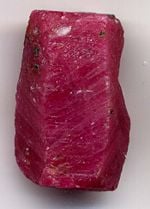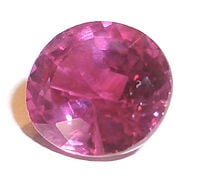Ruby
- This article is about the mineral. For other uses of the term, see Ruby (disambiguation).
| Ruby | |
|---|---|
 Ruby crystal before faceting, length 0.8 inches (2 cm) |
|
| General | |
| Category | Mineral |
| Chemical formula | aluminium oxide with chromium, Al2O3::Cr |
| Identification | |
| Color | Red, may be brownish or purplish |
| Crystal habit | Varies with locality. Terminated tabular hexagonal prisms. |
| Crystal system | Hexagonal |
| Cleavage | No true cleavage |
| Fracture | Uneven or conchoidal |
| Mohs Scale hardness | 9.0 |
| Luster | Vitreous |
| Refractive index | ~1.762-1.770 |
| Pleochroism | Orangy Red, Purplish Red |
| Streak | white |
| Specific gravity | 4.0 |
| {{{density}}} | |
| Fusibility | perfectly |
| Major varieties | |
| Pink sapphire | Caused by a color impurity and makes the stone appear pink. |
Ruby is a red gemstone, a variety of the mineral corundum (aluminium oxide). The color is caused mainly by chromium. Its name comes from ruber, Latin for red. Natural rubies are exceptionally rare, but synthetic rubies (sometimes called created ruby) can be manufactured fairly cheaply. Other varieties of gem-quality corundum are called sapphires. It is considered one of the four precious gems together with the sapphire, the emerald and the diamond.
Rubies are mined in Africa, Asia, Australia,Greenland, and North Carolina. They are most often found in Myanmar (Burma), Sri Lanka, Kenya, Madagascar, and Thailand, but they have also been found in the U.S. states of Montana, North Carolina and South Carolina. The Mogok Valley in Myanmar has produced some of the finest rubies but in recent years very few good rubies have been found there. In central Myanmar the area of Mong Hsu also produces rubies. The latest ruby deposit to be found in Myanmar is situated in Nam Ya. In 2002 rubies were found in the Waseges River area of Kenya. Rubies are being mined at Audilamena in northeastern Madagascar. Sometimes spinels are found along with rubies in the same rocks and are mistaken for rubies. However, fine red spinels may approach the average ruby in value.
Rubies have a hardness of 9.0 on the Mohs scale of mineral hardness. Among the natural gems only diamond is harder.
Ruby gemstones are valued according to size, color, clarity and cut. All natural rubies have imperfections in them, including color impurities and inclusions of rutile needles known as "silk". If there is no silk in the stone, that shows that the stone was heated to a temperature of up to 1800°C in an oven to give the ruby a better color of red. Usually the rough stone is heated before cutting. About 90% of all rubies today are heated. Rubies that are not heated are considered unusual. Some rubies undergo a process of low tube heat. This is when the stone is heated over charcoal of a temperature of about 1300 degrees Celsius for 20 to 30 minutes. The silk is partially broken and the color is improved
Phenomenon
Rubies occasionally show an optical phenomenon called asterism when cut into a cabochon. These are called "star rubies" and can be more valuable than normal rubies because asterism is rare. They also very rarely show color change and chatoyancy.
Synthetic and imitation rubies
Synthetic rubies have been made since the late 19th century. They have become more common since the work of Auguste Verneuil and the introduction of the flame fusion process. Other processes in which synthetic rubies can be produced are through the Pulling process, flux process, and the hydrothermal process. Most synthetic rubies originate from flame fusion, due to the low costs involved. Synthetic rubies may have no imperfections visible to the naked eye but magnification may reveal curved striae and gas bubbles. The fewer the number and the less obvious the imperfections, the more valuable the ruby is; unless there are no imperfections (i.e., a "perfect" ruby), in which case it will be suspected of being artificial. Dopants are added to some manufactured rubies so they can be identified as synthetic, but most need gemmological testing to determine their origin. Imitation rubies have also been present in the gemstone market for some time. Red spinel, red garnet and even glass have been falsely named as rubies. Trade terms such as balas ruby for red spinel and rubellite for red tourmaline can mislead unsuspecting buyers. Such terms are therefore discouraged from being used by many gemological associations such as the Gemological Institute of America (GIA).
Identifying Synthetic Rubies
Most synthetic rubies can only be identified using at least a 10x magnification microscope or a loupe or a light source such as a lamp or a penlight.
Flame Fusion
- Show curved growth lines
- May also show included gas bubbles
Pulling
- Curved growth lines
Flux
- Translucent to opaque included crystals or liquids
- Wispy like veils (cloud like structure within a ruby)
- Wavy fingerprint-like inclusions
Other than fluorescence, magnification is the only way to differentiate between a synthetic and a natural ruby.
Records
Although pieces of red corundum can be found weighing many kilograms, they are generally not of sufficient quality to be valuable as gemstones. For this reason, auction prices are the best indicator of a stone's true value, and prices do not necessarily correlate with size. As of 2006, the record price paid at auction for a single stone was $5,860,000 for an unnamed 38.12 carat cabochon-cut ruby.[1] However, other stones with potentially greater value may never have been sold at auction.
Trivia
- A synthetic ruby crystal was used to create the first laser.
- According to Rebbenu Bachya, the word odem in the verse Exodus 28:17 means "ruby"; it was the stone on the Ephod representing the tribe of Reuben. Modern Hebrew has taken this meaning.
- Ruby is also the most commonly named precious stone in the Bible; an example being Proverbs 31: "A virtuous wife is worth more than rubies."
- The famous lighted "Red Stars" mounted above Kremlin spires, thought to be giant rubies mined in Siberia, are actually colored glass.[1]
- Ruby is the birthstone associated with July.
- Ruby symbolizes passionate love.
- Although their names bears some similarity, rubies are not related to rubidium, and they don't contain this chemical element. Both names derive from the same Latin word, ruber, describing their reddish color.
ReferencesISBN links support NWE through referral fees
- ↑ Kremlin stars
See also
- List of minerals
ar:ياقوت bg:Рубин da:Rubin de:Rubin et:Rubiin es:Rubí eo:Rubeno fa:یاقوت fr:Rubis ko:루비 it:Rubino he:אודם lv:Rubīns lt:Rubinas nl:Robijn (edelsteen) ja:ルビー no:Rubin ug:قىزىل ياقۇت pl:Rubin pt:Rubi ro:Rubin ru:Рубин fi:Rubiini sv:Rubin vi:Hồng ngọc zh-yue:紅寶石 zh:红宝石
